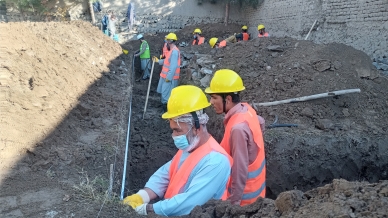The mountainous environment, geographic isolation, dependence on agriculture and impact of climate change all contribute to making residents in many parts of Afghanistan highly vulnerable to disasters. Floods, earthquakes, droughts, landslides and avalanches take lives and livelihoods.
The Aga Khan Agency for Habitat (AKAH) has worked with communities in Afghanistan since 1996, when its predecessor, FOCUS, began responding to acute food shortages. Since then we have developed 728 village disaster management plans, and established, trained and equipped 100 response teams in 2021 and 746 response teams overall. AKAH has also responded to over 1,910 disasters.
Our work continues through the recent change in Government. We are supporting vulnerable populations in northern and northeastern provinces of Afghanistan, providing humanitarian aid and building disaster resilience.
akah-afghanistan-installing_emergency-r.jpg

“AKAH takes a coordinated and proactive approach to help communities reduce disaster risk,” said Shodmon Hojibekov, CEO, AKAH Afghanistan.
“First, we work with communities to take measures to prevent problems – by building walls or planting trees to slow a landslide or promoting safer building techniques and planning. Next, we make sure communities are trained and know when and where to evacuate or are equipped to provide first aid and emergency rescue if disaster strikes. Finally, we help them build back better when the worst happens.”
Prevention
AKAH has worked on disaster risk reduction in Afghanistan since 2008, strengthening the capacity of communities and the authorities to assess, prepare for and respond to disasters. We have worked with nearly 800 communities to assess the risks and vulnerability they face to multiple natural hazards, and to implement measures to mitigate these risks. We continue to update these assessments and expand these measures.
This year, we worked with the UN refugee agency, UNHCR, on a resilient housing project. Twenty-five skilled labourers learned how to construct safe houses, rehabilitate them when needed and retrofit dwellings against earthquakes, floods, debris flows, avalanches and other natural disasters. The theoretical session covered hazard identification, site selection, building typology, masonry structures, concrete structures and safety in construction. Participants then put their knowledge into practice, building their skills in everything from stone masonry to carpentry as they constructed a model house under the guidance of an AKAH engineer.
akah-afghanistan-construction_of_model_house_and_permanent_shelter_in_badakhshan_province_4r.jpg

We are also working to introduce lower-carbon, greener building designs and techniques to help communities adapt to and mitigate climate change. We have trained 25 masons to produce building blocks locally that mix local sand and gravel with lower quantities of cement. These create concrete blocks with lower thermal conductivity, for improved energy efficiency. We are training masons to use these materials along with local stone masonry in seismically resistant, safer and more energy-efficient construction techniques and home designs.
Response
While disasters cannot be entirely averted, preparation saves lives. In Afghanistan’s remote mountain areas, where access for outside help can be challenging, it is essential to have trained emergency first responders locally. In 2021, AKAH’s Emergency Management Department trained 2,426 people in emergency response. This included training 2,050 people in avalanche prevention and response.
akah-afghanistan-ashorbaik_school_emergency_response_team.jpg

We have trained 690 people to form School Emergency Response Teams and 100 people to form Hospital Emergency Response Teams. This ensures that if disaster strikes people within the community are trained to help organise evacuations and shelters, and provide first aid. This winter, these trained volunteers helped evacuate 519 people to safety during more than 451 avalanche incidents across AKAH’s programme areas.
We have installed emergency communication systems in 187 villages, and maintain regular contact with them. Sixty-eight villages have no means of communication, and we will address this for a further 53 villages in 2022. The 65,450 residents of these remote, isolated and high-risk villages can now call our 24/7 emergency team in the event of an incident.
Rebuilding
The Sargaz Bridge enables the nearby villagers to import supplies, access hospitals and markets and send children to attend school across the river. First built by FOCUS in 2007, it has been destroyed twice by heavy rain and glacial melts, causing mud and debris flows.
akah-afghanistan-sargaz_bridge.jpg

Following a community request, AKAH rebuilt and reinforced the Sargaz road and bridge with steel beams and plates. Over 1,400 residents from six villages have directly benefitted, as have the wider communities of Wakhan and Pamir.
“The people who live in the vicinity of the bridge were unable to commute to the other side of the river, creating significant challenges. Women and students who needed access to schools or their place of work were stranded,” said Faridoon Sharifi, Field Engineer, AKAH Afghanistan. “However, they can now easily access their homes and workplaces.”
Latest On AKDN




